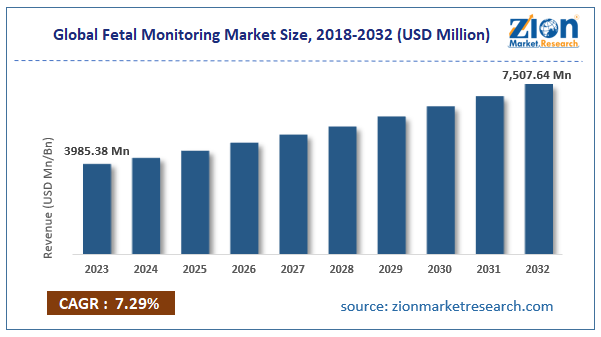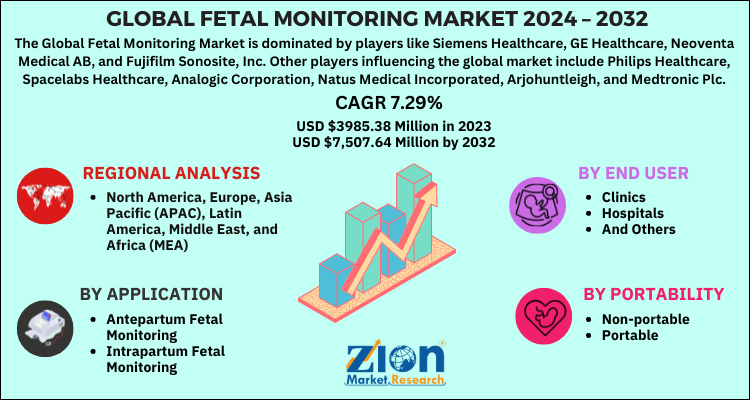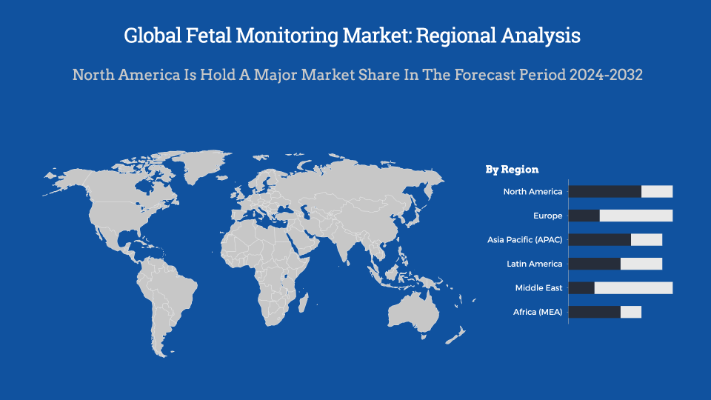Fetal Monitoring Market Size, Share, Demand, Growth Analysis Report 2032

Fetal Monitoring Market By End user (clinics, hospitals, and others), By portability (non-portable and portable), By Application (antepartum fetal monitoring and intrapartum fetal monitoring) And By Region: - Global and Regional Industry Overview, Market Intelligence, Comprehensive Analysis, Historical Data, and Forecasts, 2024-2032
| Market Size in 2023 | Market Forecast in 2032 | Growth Rate (in %) | Base Year |
|---|---|---|---|
| USD 3985.38 Million | USD 7,507.64 Million | CAGR at 7.29% | 2023 |
Description
Global Fetal Monitoring Market: Insights
According to the report published by Zion Market Research, the global Fetal Monitoring Market size was valued at USD 3985.38 Million in 2023 and is predicted to reach USD 7,507.64 Million by the end of 2032. The market is expected to grow with a CAGR of 7.29% during the forecast period.
Global Fetal Monitoring Market: Overview
A diagnostic tool used to monitor movement and the heart rate of the fetus and maternal contractions is known as the fetal monitoring system. It is a fundamental device used for monitoring uterine contractions during labor. It mainly monitors the well-being of the fetus and progress of labor. In medical terms, it is referred as the medical method to check the health of an unborn baby to ensure a safe birth. In addition, it also used to monitor chronic lung diseases, mental retardation, neonatal diseases, hypothermia, vision & hearing problems, and jaundice.
Global Fetal Monitoring Market: Growth Factors
The increase in demand for fetal monitoring during pregnancy is anticipated to drive the global fetal monitoring market growth. Technological advancements and surge in preterm births and birth rates are expected to propel the global market growth in future. In addition, growth in the premature delivery rate, hemorrhage rate, and surge in the need for fetal monitoring supplement may enhance the global market in a positive way. Furthermore, the emergence of the portable and wireless products, and technologies, and untapped emerging economies have opened up gateways for the lucrative growth opportunities globally. Conversely, stringent regulatory procedures, low prevalence of birth rates, the high cost of equipment may obstruct the global fetal monitoring market.
Key Insights
- As per the analysis shared by our research analyst, the global Fetal Monitoring Market is estimated to grow annually at a CAGR of around 7.29% over the forecast period (2024-2032).
- In terms of revenue, the global Fetal Monitoring Market size was valued at around USD 3985.38 Million in 2023 and is projected to reach USD 7,507.64 Million by 2032.
- Based on the end user, the Hospitals and Maternity Hospitals this segment holds the largest market share, accounting for approximately 68% in 2023. The dominance is due to the high volume of deliveries and the availability of advanced fetal monitoring technologies in these settings. Hospitals are equipped to handle a wide range of situations, from routine monitoring to high-risk pregnancies, contributing to their leading position in the market.
- Based on the portability, Portable fetal monitoring devices have captured a significant market share, with figures around 62% in 2023. Their convenience, ease of use, and cost-effectiveness make them a preferred choice across various healthcare settings, including hospitals, clinics, and home care. The ability to provide real-time data and alerts facilitates timely interventions, enhancing patient outcomes.
- Based on the application, the Antepartum Fetal Monitoring this segment dominates the application category, holding approximately 64% of the market share in 2023. The growth is attributed to the increasing incidence of preterm labor and the rising demand for early detection of fetal distress. Antepartum monitoring is crucial for assessing fetal well-being before labor, enabling timely interventions and reducing the risk of adverse outcomes.
- Based on the region, the North America leads the global fetal monitoring market, with a revenue share of 38.7% in 2023. Factors contributing to this dominance include the presence of major market players, advanced healthcare infrastructure, high purchasing power, and a heightened awareness of fetal health monitoring among healthcare professionals and the population.
Fetal Monitoring Market: Dynamics
Key Growth Drivers
The fetal monitoring market is primarily driven by the increasing prevalence of preterm births, high-risk pregnancies, and maternal health complications, necessitating continuous monitoring during pregnancy and childbirth. Advances in fetal monitoring technology, including wireless and portable devices, enhance patient comfort and enable remote monitoring, contributing to market growth. Additionally, rising awareness about the importance of fetal health monitoring and increased healthcare expenditure in both developed and developing regions further stimulate market demand. Government initiatives promoting maternal and child healthcare, coupled with the growing adoption of advanced healthcare infrastructure, also support the expansion of the fetal monitoring market.
Restraints
Despite its growth potential, the fetal monitoring market faces several restraints, including the high cost of advanced monitoring systems, which may limit their adoption in low-resource settings. A lack of skilled healthcare professionals to operate and interpret monitoring devices can further hinder market growth, particularly in developing countries. Additionally, concerns over the potential risks associated with continuous electronic fetal monitoring (EFM), such as false-positive results leading to unnecessary medical interventions, can restrict its widespread use. Stringent regulatory guidelines and lengthy approval processes for new devices may also slow down product launches and market expansion.
Opportunities
Emerging technologies, such as artificial intelligence (AI) and machine learning (ML), present significant opportunities in the fetal monitoring market by enabling predictive analysis and improving diagnostic accuracy. The increasing demand for home-based and remote monitoring solutions, driven by the growing popularity of telehealth, also opens new avenues for market players. Furthermore, the development of wearable and non-invasive fetal monitoring devices enhances patient convenience and expands market reach. Collaborations between healthcare providers and medical device companies for research and innovation can further accelerate market growth. Additionally, government support in the form of funding and awareness programs offers substantial growth opportunities, particularly in underserved regions.
Challenges
The fetal monitoring market faces challenges such as the limited accessibility of advanced monitoring technologies in rural and economically disadvantaged areas. Insufficient healthcare infrastructure and the lack of standardized medical protocols in developing countries can further restrict market growth. Additionally, the risk of device malfunction, data misinterpretation, and cybersecurity concerns associated with digital monitoring systems pose significant challenges. Resistance to adopting new monitoring technologies among healthcare providers due to concerns over reliability and cost-effectiveness may also hinder market penetration. Addressing these challenges requires continuous innovation, regulatory compliance, and enhanced training programs for healthcare professionals.
Fetal Monitoring Market: Report Scope
| Report Attributes | Report Details |
|---|---|
| Report Name | Fetal Monitoring Market |
| Market Size in 2023 | USD 3985.38 Million |
| Market Forecast in 2032 | USD 7,507.64 Million |
| Growth Rate | CAGR of 7.29% |
| Number of Pages | 199 |
| Key Companies Covered | Siemens Healthcare, GE Healthcare, Neoventa Medical AB, and Fujifilm Sonosite, Inc. Other players influencing the global market include Philips Healthcare, Spacelabs Healthcare, Analogic Corporation, Natus Medical Incorporated, Arjohuntleigh, and Medtronic Plc. |
| Segments Covered | By End User, By Portability, By Application And By Region |
| Regions Covered | North America, Europe, Asia Pacific (APAC), Latin America, Middle East, and Africa (MEA) |
| Base Year | 2023 |
| Historical Year | 2018 to 2022 |
| Forecast Year | 2024 - 2032 |
| Customization Scope | Avail customized purchase options to meet your exact research needs. Request For Customization |
Global Fetal Monitoring Market: Segmentation
The global fetal monitoring market is segmented based on End user, Portability, Application and Regions. All the segments of fetal monitoring market have been analyzed based on present and future trends and the market is estimated from 2024 to 2032.
Based on End User,The global fetal monitoring market is divided based on the end user as clinics, hospitals, and others.
Based on Portability, the global market is categorized as non-portable and portable.
Based on application, the global fetal monitoring market is further fragmented as antepartum fetal monitoring and intrapartum fetal monitoring. Moreover, the global market is classified on the basis of technique as non-invasive and invasive. Furthermore, the global fetal monitoring market is segmented on the basis of the product as instruments & consumables software.
The regional segment includes the current and forecast demand for North America, Europe, Asia Pacific, Latin America, and the Middle East and Africa.
Global Fetal Monitoring Market: Regional Analysis
The fetal monitoring market demonstrates varied growth patterns across different regions, influenced by factors such as healthcare infrastructure, technological advancements, and demographic trends.
North America
North America represents a mature market for fetal monitoring, characterized by the widespread adoption of advanced technologies and stringent regulatory standards. In 2024, the U.S. led the region with approximately USD 2 billion in revenue, driven by the increasing prevalence of pregnancy-associated complications like gestational diabetes, which affects 2% to 10% of pregnant women annually. This underscores the demand for advanced fetal monitoring devices to manage potential risks effectively.
Europe
Europe remains a key market, with countries like Germany, France, and the UK emphasizing maternal and child health. The UK, for instance, has experienced concerning stillbirth rates, with approximately 1 in every 250 pregnancies ending in stillbirth in 2022, equating to 8 stillbirths daily. These statistics highlight the critical need for effective fetal monitoring systems to detect and address potential complications early.
Asia-Pacific
The Asia-Pacific region is poised for significant growth, driven by increasing healthcare awareness, rising disposable incomes, and substantial investments in healthcare infrastructure. Countries like China, India, and Japan are at the forefront, with large populations and a growing focus on maternal and child health. Government initiatives, such as India's Pradhan Mantri Surakshit Matritva Abhiyan (PMSMA), which provides free maternal care services, are enhancing the adoption of fetal monitoring devices.
Latin America
Latin America presents growth opportunities due to rising income levels and urbanization, leading to increased healthcare expenditure. Countries like Brazil, Argentina, and Colombia are witnessing heightened demand for fetal monitoring devices, propelled by improved healthcare infrastructure and a greater number of high-risk pregnancies. Strategies focusing on building robust distribution networks and forming partnerships with local healthcare providers are essential for market expansion in this region.
Middle East and Africa
The Middle East and Africa offer growth potential, supported by improving healthcare infrastructure and increasing awareness of maternal and child health. For example, Saudi Arabia's high birth rate, reported at 16.92 per thousand people in 2022, drives the demand for advanced fetal monitoring solutions to ensure safer pregnancies and deliveries.
Global Fetal Monitoring Market: Competitive Players
Major players dominating the global fetal monitoring market are:
- Siemens Healthcare
- GE Healthcare
- Neoventa Medical AB
- Fujifilm Sonosite, Inc.
Other players influencing the global market include
- Philips Healthcare
- Spacelabs Healthcare
- Analogic Corporation
- Natus Medical Incorporated
- Arjohuntleigh
- Medtronic Plc.
The Global Fetal Monitoring Market is segmented as follows:
By End User
- Clinics
- Hospitals
- And Others
By Portability
- Non-portable
- Portable
By Application
- Antepartum Fetal Monitoring
- Intrapartum Fetal Monitoring
By Region
- North America
- U.S.
- Europe
- UK
- France
- Germany
- Asia Pacific
- China
- Japan
- India
- Latin America
- Brazil
- The Middle East and Africa
What Report Provides
- Full in-depth analysis of the parent market
- Important changes in market dynamics
- Segmentation details of the market
- Former, on-going, and projected market analysis in terms of volume and value
- Assessment of niche industry developments
- Market share analysis
- Key strategies of major players
- Emerging segments and regional markets
- Testimonials to companies in order to fortify their foothold in the market.
Table Of Content
FrequentlyAsked Questions
A diagnostic tool used to monitor movement and the heart rate of the fetus and maternal contractions is known as the fetal monitoring system. It is a fundamental device used for monitoring uterine contractions during labor. It mainly monitors the well-being of the fetus and progress of labor. In medical terms, it is referred as the medical method to check the health of an unborn baby to ensure a safe birth. In addition, it also used to monitor chronic lung diseases, mental retardation, neonatal diseases, hypothermia, vision & hearing problems, and jaundice.
The Fetal Monitoring Market was valued at USD 3985.38 Million in 2023.
The Fetal Monitoring Market is expected to reach USD 7,507.64.66 Million by 2032, growing at a CAGR of of 7.29% between 2024 to 2032.
Technological advancements and surge in preterm births and birth rates are expected to propel the global market growth in future. In addition, growth in the premature delivery rate, hemorrhage rate, and surge in the need for fetal monitoring supplement may enhance the global market in a positive way. Furthermore, the emergence of the portable and wireless products, and technologies, and untapped emerging economies have opened up gateways for the lucrative growth opportunities globally. Conversely, stringent regulatory procedures, low prevalence of birth rates, the high cost of equipment may obstruct the global fetal monitoring market.
Fetal Monitoring Market players such as Siemens Healthcare, GE Healthcare, Neoventa Medical AB, and Fujifilm Sonosite, Inc. Other players influencing the global market include Philips Healthcare, Spacelabs Healthcare, Analogic Corporation, Natus Medical Incorporated, Arjohuntleigh, and Medtronic Plc.
HappyClients
Zion Market Research
Tel: +1 (302) 444-0166
USA/Canada Toll Free No.+1 (855) 465-4651
3rd Floor,
Mrunal Paradise, Opp Maharaja Hotel,
Pimple Gurav, Pune 411061,
Maharashtra, India
Phone No +91 7768 006 007, +91 7768 006 008
US OFFICE NO +1 (302) 444-0166
US/CAN TOLL FREE +1 (855) 465-4651
Email: sales@zionmarketresearch.com
We have secured system to process your transaction.
Our support available to help you 24 hours a day, five days a week.
Monday - Friday: 9AM - 6PM
Saturday - Sunday: Closed








